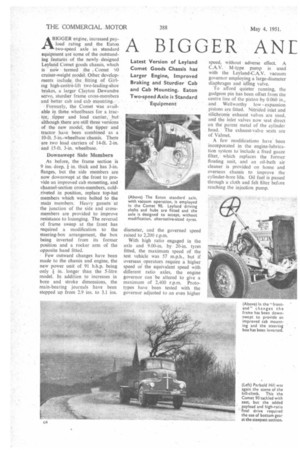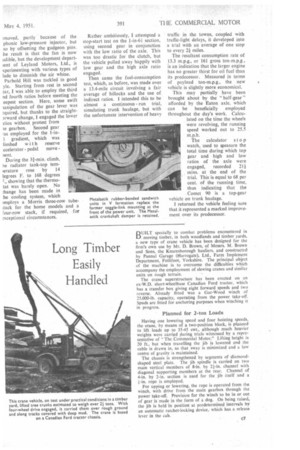A BIGGER ANL TTER COMET
Page 42

Page 43

Page 44

Page 45

If you've noticed an error in this article please click here to report it so we can fix it.
By L. J. COTTON, M .I.R.T.E. BIGGER engine, increased pay
load rating and the Eaton
two-speed axle as standard equipment are some of the outstanding features of the newly, designed Leyland Comet goods chassis, which is . now termed the Comet VO cruiser-weight model. Other developments include the fitting of Girlmg high-centre-lift two-leading-shoe brakes, a larger Clayton Dewandre servo, sturdier frame cross-members and better cab and cab mounting.
Formerly, the Comet was available in three wheelbases for a tractor, tipper and load carrier, but although there are still three versions of the new model, the tipper and tractor have been combined as a 10-ft. 5-in.-wheelbase chassis. There are two load carriers of 14-ft. 2-in. and 15-ft. 3-in. wheelbase.
Downswept Side Members
As before, the frame section is 9 ins. deep, I in. thick and has 3-in. flanges, but the side members are now downswept at the front to provide an improved cab mounting, and channel-section cross-members, coldriveted in position, replace top-hat members which were bolted to the main members, Heavy gussets at the junction of the side and crossmembers are provided to improve resistance to lozenging. The reversal of frame sweep at the front has required a modification to the steering-box arrangement, the box being inverted from its former position and a rocker arm of the opposite hand fitted.
Few outward changes have been made to the chassis and engine, the new power unit of 91 b.h.p. being only I in. longer than the 5-litre model. In addition to increases in bore and stroke dimensions, the main-bearing journals have been stepped up from 2.9 ins. to 3.1 ins. diameter, and the governed speed raised to 2,200 r.p.m.
With high ratio engaged in the axle and 9.00-in. by 20-in. tyres fitted, the maximum speed of the test vehicle was 57 m.p.h., but if overseas. operators require a higher speed or the equivalent speed with different ratio axles, the engine governor can be altered to give a maximum of 2,400 r.p.m. Prototypes have been tested with the governor adjusted to an even higher speed, without adverse effect. A C.A.V. M-type pump is used with the Leyland-C.A.V. vacuum governor employing a large-diameter diaphragm and idling valve.
To afford quieter running, the gudgeon pin has been offset from the centre line of the piston-by 0.060 in., .and Wellworthy low expansion pistons are fitted. Nitrided inlet and silichrome 'exhaust valves are used, and the inlet valves now seat direct on the parent metal of the cylinder head. The exhaust-valve seats are of Valmet.
A few modifications have been incorporated in the engine-lubrication system to include a fixed gauze filter,which replaces the former floating unit, and an oil-bath air cleaner is provided on home and overseas chassis to improve the cylinder-bore life: Oil fuel is passed through a cloth and felt filter before reaching the injection pump.
Sheet-metal pressings replace the ;ht-alloy valve cover and engine mp, and a slight modification has en made to the head to provide a t-face attachment between the anifolds and ports, instead of Inken faces with flush-fitting ,skets.
The toggle-link mounting has been ,perseded by the Metalastik rubbermded sandwich units in V formaMI at the front of the engine timing se, but the normal link arrangeent is retained at the flywheel msing, which is now machined on le side flanges to S.A.E. standards. he Metalastik crankshaft damper is tamed.
The single-dry-plate clutch is fitted ith non-metallic facings, which are otted radially and, in conjunction ith radial holes drilled in the flyheel, induce a cooling current of r. A slight alteration has been lade to the clutch plate, which is )vt! equipped with a flexible centre. Hardy Spicer type 1500 propeller shafts are retained, but the Eaton 16500 heavy-duty axle replaces the former fixed-ratio unit. No single ratio axles are offered for the Comet 90, but the operator has the choice of three two-speed units of 4.59 and 6.8, 5.62 and 7.81, or 6.14 and 8.52 to 1 ratios. The Eaton standard axle is used with Leyland driving shafts and hubs.
Both front and rear axles are designed to accept 9.00-in. or 10.00-in. by 20-in. tyre equipment without modification. A heavier section front axle is now provided to offset the increased load, and parallel kingpins are fitted.
As before, the braking system has Clayton Dewandre servo and Girling hydraulic operation, but a 7-in. vacuum cylinder replaces the 5-in. unit, and high-centre-lift shoes with two-leading-shoe action in both directions are fitted. The hydraulic cylinders and 0.110-in, centre-lift shoe have been developed by Girling to combat brake fade.
To improve the ventilation of the rear drums, their diameter has been decreased by l in., but the frictionfacing lengths have been increased to afford 39.6 sq. ins, of brake facing per ton when the chassis is loaded to 12 tons gross. In effect, the brake frictional area has been increased from 450 sq. ins, to 480 sq. ins Cast-iron brake drums are employed.
Smoother riditig has been achieved by increasing the front-spring lengths from 45 ins. to 52 ins, and raising the deflection from 2.35 ins, to 3.2 ins Apart from a slight increase in deflection, no alteration has been made to the rear springs. The new Comet is available with 9,00-in. by 20-in tyres for the home market, giving a maximum gross load of 21,000 lb. (9 tons 8 cwt.), or with 10.00-in. by 20-in. or 36-in. by 8-in. equipment, which increases the permissible gross weight to 26,000 lb (11 tons 12 cwt.) for domestic use and to 24,000 lb. (10 tons 14 cwt.) in tropical areas.
Improved Cab Mounting
Five-point mounting is retained for the cab, but larger and more resilient rubber pads are provided, and the underframe has been modified for the down-sweep of the chassis. This underframe has been increased in strength by additional cross sills and flanging.
New-shape fuel and vacuum tanks, made in pressed-steel halves and joined by welding at the seams, have been developed. This method of construction has been adopted chiefly to facilitate production, but being made of 16 s.w.g. sheec steel, they are stronger than the former cylindrical receptacles and are no heavier.
The test vehicle weighed 4 cwt. more in chassis and cab form in comparison with the Mark I model of the same wheelbase, which was tested in 1948, but the gross weight was raised by 2 tons to 12 tons 24 cwt. It was equipped for trunk haulage, having axle ratios of 4.89 and 6.8 to 1.
I used the course followed during the 1948 trials, to make a comparison in performance. First came the acceleration trials on the level Lancashire Road, where, with the lower ratio of the axle engaged, 30 m.p.h. was reached from standstill in an average of 35.5 secs. This was 8 secs. slower than the time required by the former Comet to reach the same speed. The new model was greatly handicapped by additional weight, but this was partially offset by a slightly lower ratio in the final drive.
c6 By comparison with the former Comet, the brake performance of the 90 model was disappointing. The longer stopping distance may be attributed to a combination of modifications in the braking system, including the low-coefficient friction facings, 10 per cent, less fraction area per ton as tested, and, of course, to the use of the solenoid-operated air pistol for testing. This showed a slight delay between applying the pedal and the shoes taking full effect on the drums.
In the main, the new brake arrangement provides consistent retardation and the shoe lift is proof against complete loss of pedal travel, as was shown during the drastic fade test which I apply to chassis of this type.
With cold drums, the test vehicle was brought to rest from 20 m.p.h. in 33.5 ft., the corresponding Tapley reading being 67 per cent. After driving for a mile against the brakes at 20 m.p.h. with fourth gear engaged, the maximum retardation recorded by the meter decreased, to 39 per cent., but this depreciation was not continued and at the end of the fifth mile the braking effect had fallen to only 31 per cent.
Recuperation after the fade test was steady, and the former deceleration rate with cold drums was restored within five miles. There was no appreciable difference in pedal travel, which indicated that little friction material had been removed.
Then followed the cross-country run to Parbold Hill, during which I took stock of the improvements in suspension and reduction of noise. The characteristic staccato cackle of the oil engine has been practically
:moved, partly because of the phonic low-pressure injector, but so by offsetting the gudgeon pins. he result is that the fan is now Ltdible, but the development depart. tent of Leyland Motors, Ltd., is K perimen ti ng with various types of lade to diminish the air whine. Parbold. Hilt was tackled in good yle. Starting from rest in second ear, I was able to employ the third hd fourth ratios before meeting the eepest section. Here, some swift tanipulation of the gear lever was !quired, but thanks to the straight3rward change, I engaged the lower itios without protest from le gearbox. Second gear as employed for the 1-in
gradient, which was limbed with reserve ccelerator pedal move lent.
During the 31-min. climb, he radiator tank-top temperature rose by 14 legrees F. to 168 degrees 7., showing that the thermotat was barely open. No ;lunge has been made in he cooling system, which :mploys a Morris three-row tube;tack for the home models and a rour-row stack, if required, for :xceptional circumstances.
Rather ambitiously, I attempted a stop-start test on the 1-in-6i section, using second gear in conjunction with the low ratio of the axle. This was too drastic for the clutch, but the vehicle pulled away happily with low gear and the high axle ratio engaged.
Then came the fuel-consumption test, which, as before, was made over a 13.4-mile circuit involving a fair average of hillocks and the use of indirect ratios. I intended this to be almost a continuous run trial, simulating trunk haulage, but with the unfortunate intervention of heavy traffic in the towns, coupled with traffic-light delays, it developed into a trial with an average of one stop to every 2i miles.
The resultant consumption rate of 13.3 m.p.g., or 161 gross ton-m.p.g., is an indication that the larger engine has no greater thirst for oil fuel than its predecessor. Measured in terms of payload ton-m.p.g., the new vehicle is slightly more economical.
This may partially have been brought about by the " half-gear " afforded by the Eaton axle, which can be beneficially employed throughout the day's work. Calculated on the time the wheels were revolving, the running speed worked out to 25.5 m.p.h.
The calculator stop watch, used to measure the total time during which top gear and high and low ratios of the axle were engaged, recorded 211 mins. at the end of the trial. This is equal to 68 per cent. of the running time, thus indicating that the Comet 90 is a top-gear vehicle on trunk haulage.
I returned the vehicle feeling sure that it represented a marked improvement over its predecessor.




































































































